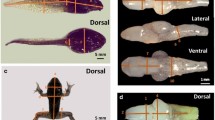Abstract
Larval amphibians are particularly likely to encounter variation in rearing temperature and resource availability due to variation in aquatic breeding habitats. In this study, plasticity in growth rates, larval mass, larval period, and size at metamorphosis were examined in Rana kukunoris Nikolskii, 1918 under different combinations of temperature and food level. Larval period and larval body mass was sensitive to food level, and varied with temperature. Tadpoles metamorphosed at an older age at low temperature than those reared at warm temperature. Food level was a significant affect on larval period at low temperature, but not at warm temperature. Mass was heavier for tadpoles reared at low temperatures than those reared at warm temperatures. The effect of food level depended on temperature, because larvae reared at low temperature that were offered a high food level achieved a larger size than larvae offered a low food level, but this did not occur at warm temperature. Therefore, we suggest that high food availability at low temperature prolonged developmental periods, thus larvae are larger as metamorphs than those reared at warm temperatures.
Similar content being viewed by others
References
Álvarez, D. and Nicieza, A.G., Effects of induced variation in anuran larval development on postmetamorphic energy reserves and locomotion, Oecologia, 2002, vol. 131, pp. 186–195.
Atkinson, D., Temperature and organism size: A biological law for ectotherms?, Adv. Ecol. Res., 1994, vol. 25, pp. 1–58.
Atkinson, D., Ectotherm life-history responses to developmental temperature, in Animals and Temperature: Phenotypic and Evolutionary Adaptation, Johnston, I.A. and Benett, E.F., Eds., Canbridge: Cambridge Univ. Press, 1996, pp. 183–204.
Beck, C.W. and Congdon, J.D., Effects of age and size at metamorphosis on performance and metabolic rates of southern toad, Buffo terrestris, metamorphs, Funct. Ecol., 2000, vol. 14, pp. 32–38.
Harkey, G.A. and Semlitsch, R.D., Effects of temperature on growth, development, and color polymorphism in the ornate chorus frog Pseudacris ornate, Copeia, 1988, vol. 1988, pp. 1001–1007.
Harris, R.N., The anuran tadpole: Evolution and maintenance, in Tadpoles: The Biology of Anuran Larvae, McDiarmid, R.W. and Altig, R., Eds., Chicago: Univ. of Chicago Press, 1999, pp. 279–294.
Laugen, A.T., Laurila, A., Rasanen, K. and Merila, J., Latitudinal countergradient variation in the common frog (Rana temporaria) development rates: Evidence for local adaptation, J. Evol. Biol., 2003, vol. 16, pp. 996–1005.
Leips, J. and Travis, J., Metamorphic responses to changing food levels in two species of hylid frogs, Ecology, 1994, vol. 75, pp. 1345–1356.
Liess, A., Rowe, O., Guo, J., Thomsson, G. and Lind, M.I., Hot tadpoles from cold environments need more nutrientslife history and stoichiometry reflects latitudinal adaptation, J. Anim. Ecol., 2013, vol. 82, pp. 1316–1325.
Merila, J., Laurila, A., Laugen, A.T., Rasanen, K. and Pahkala, M., Plasticity in age and size at metamorphosis in Rana temporara: Comparison of high and low latitude populations, Ecography, 2000, vol. 23, pp. 457–465.
Newman, R.A., Ecological constraints on amphibian metamorphosis: Interactions of temperature and larval density with responses to changing food level, Oecologia, 1998, vol. 115, pp. 9–16.
Palo, J.U., O’Hara, R.B., Laugen, A.T., Laurila, A., Primmers, C.R. and Merila, J., Latitudinal divergence of common frog (Rana temporaria) life history traits by natural selection: Evidence from a comparison of molecular and quantitative genetic data, Mol. Ecol., 2003, vol. 2, pp. 1963–1978.
Pandian, T.J. and Marian, M.P., Predicting anuran metamorphosis and energetics, Physiol. Zool., 1985, vol. 58, pp. 538–552.
Semlitsch, R.D., Scott, D.E., and Pechmann, J.H.K., Time and size at metamorphosis related to adult fitness in Ambystoma talpoideum, Ecology, 1988, vol. 69, pp. 184–192.
Semlitsch, R.D., Pickle, J., Parrish, M.J. and Sage, R.D., Jumping performance and short-term repeatability of newly metamorphosed hybrid and parental leopard frogs (Rana sphenocephala and Rana blairi), Can. J. Zool., 1999, vol. 77, pp. 748–754.
Smith-Gill, S.J. and Berven, K.A., Predicting amphibian metamorphosis, Am. Nat., 1979, vol. 113, pp. 563–585.
Tracy, C.R., Christian, K.A., O’Connor, M.P. and Tracy, C.R., Behavioral thermoregulation by Bufo americanus: The importance of the hydric environment, Herpetologica, 1993, vol. 49, pp. 375–382.
Wells, K.D., The social behaviour of anuran amphibians, Anim. Behav., 1977, vol. 25, pp. 666–693.
Werner, E.E., Amphibian metamorphosis: Growth rate, predation risk and the optimal size at transformation, Am. Nat., 1986, vol. 128, pp. 319–341.
Wilbur, H.M. and Collins, J.P., Ecological aspects of amphibian metamorphosis, Science, 1973, vol. 182, pp. 1305–1314.
Xie, F., Ye, C.Y., Fei, L., Jiang, J.P. and Masafumi, M., Taxonomical studies on the populations of Rana chensinsis in north-western China (Amphibia: Ranidae), Acta Zootaxonomica Sinica, 2000, vol. 25, pp. 228–235.
Yu, T.L., Li, H.J., and Lu, X., Mating patterns of Rana kukunoris from three populations along an altitudinal gradient on the Tibetan Plateau, Anim. Biol., 2013, vol. 63, pp. 131–138.
Zhang, R.Z., Zoogeography of China, Beijing: Science Press, 1999.
Author information
Authors and Affiliations
Corresponding author
Additional information
The article is published in the original.
Rights and permissions
About this article
Cite this article
Yu, T.L., Han, Y.T. & Zhang, S.P. Plasticity in metamorphic traits of Rana kukunoris tadpoles: The interactive effects of food level and rearing temperature. Russ J Ecol 47, 552–556 (2016). https://doi.org/10.1134/S1067413616050131
Received:
Published:
Issue Date:
DOI: https://doi.org/10.1134/S1067413616050131



